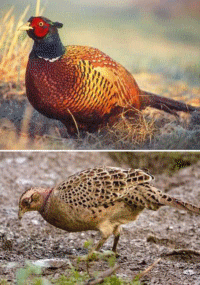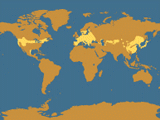 SKC Films Library SKC Films Library |
| SKC Films Library >> Science >> Zoology >> Birds >> Order Galliformes |
 Ring-Necked Pheasant Ring-Necked PheasantPhasianus colchicus Description The male ring-necked pheasant is easily distinguished from other species by its blue-green head, red face wattles, white neck ring, and brightly-colored body, in stark contrast to the drab, mottled brown female. The cock also has a spur on the back of each leg, just above the foot, which is not present on the hen. Adults range from 21 to 36 inches in length, have a wingspan of 28-34 inches, and weigh 1-3 pounds, will cocks larger than hens. Both sexes have a long, pointed tail.
Originally native to eastern Asia, the ring-necked pheasant is now well-established in both Europe and North America, having been introduced into both areas as a game bird. In both its native and introduced ranges, the ring-necked pheasant is most commonly found in open uplands, including farm fields, rangeland, brush, woodland edges, and hedgerows. Reproduction In North America, most breeding takes place in May and June. The cock courts by strutting around the hen and displaying his plumage. Courtship can take several weeks, during which the cock gathers a harem of 3-7 or more hens, which he will aggressively "protect" from other cocks. Each hen selects her own nest site, which is usually little more than shallow depression in the ground lined with vegetative material. She alone incubates the 7-14 brownish-olive eggs for about 24 days. The hatchlings can leave the nest and feed themselves almost immediately, but they will be watched over by their mother until able to fly, which usually takes about 2 weeks. Sexual maturity is reached at about 18 weeks. Diet These omnivorous birds feed primarily on grains, seeds, roots, berries, buds, etc. in the winter, switching to insects, spiders, earthworms, snails, etc. in the summer. Breeding hens and young chicks eat a greater proportion of animal matter than the rest of the population. While laying eggs, hens will also eat large quantities of high-calcium snail shells. Other Behavior In very bad weather, pheasants are known to stay on a roost for several days without eating. In the winter, they often appear in segregated flocks, males in small groups and females in larger groups. They do not migrate. Although they can take rapidly to the air when startled, pheasants are more likely to run from danger. Scientific Classification phylum Chordata |
| SKC Films Library
>> Science
>> Zoology >> Birds >> Order Galliformes This page was last updated on June 21, 2017. |
 Distribution
and Habitat
Distribution
and Habitat